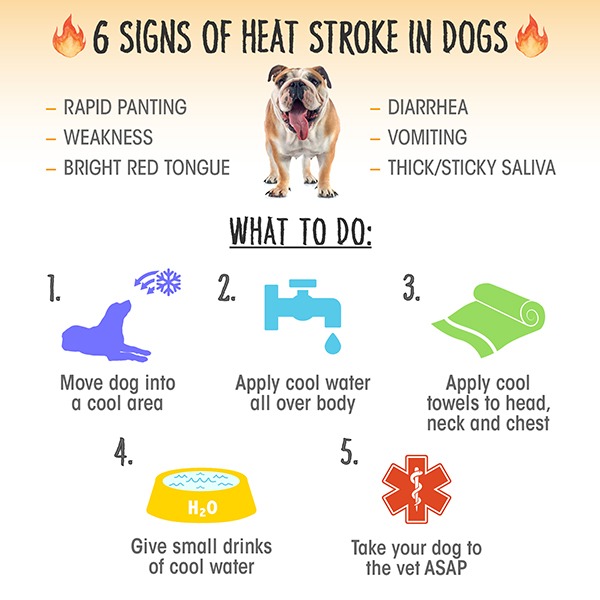How heat stroke can effect dogs…
Heat stroke is more serious than you may think.
How heat stroke can effect dogs is surprising and can be extremely serious, if not spotted. This is why it is important we have as much information as possible. That way we can look after our fur babies, the best we can.
Heat stroke is a life threatening condition that’s brought on by a sudden rise in body temperature.
What is it?
Heat stroke is a form of nonpyrogenic hyperthermia.
This essentially means a high temperature not caused by a fever.
It occurs when dogs are no longer able to self regulate and keep their temperature at a comfortable level.
How can it affect my dog?
Heat stroke can lead to organ failure very quickly.
As a result, the survival rate for dogs diagnosed with the condition is poor.
One of the largest studies ever carried out into the prognosis and outcome of dogs with heat stroke showed a mortality rate of 50%.
Another study into heat-induced illness in dogs found that those cooled before arriving at the vet had a much lower mortality rate (19%) than those not cooled (49%).
How does it happen?
It commonly affects pets who are exercised outside on a hot day.
Or are carelessly left in a car or conservatory during warm weather.
There are many cases of heat stroke diagnosed in dogs every year and, tragically, many of these prove to be fatal.
Are there any dog breeds more likely to suffer?
Dogs who are obese or suffer from brachycephalic syndrome (upper airway abnormalities typically affecting flat-faced breeds) are most likely to experience heat stroke.
However, don’t be lulled into a false sense of security if your dog is fit and healthy.
All dogs can easily overheat if they’re exposed to hot temperatures and a lack of ventilation and drinking water.
Signs & symptoms
Spotting the signs of heat stroke early, and seeking emergency treatment, can massively increase your dog’s chance of survival.
There are two types of heat stroke; exertional and non-exertional.
The first occurs during exercise and is much more common on hot sunny days. This is when dogs haven’t had a chance to acclimatise to the sudden rise in heat.
Dogs can take up to 60 days to acclimatise to significant changes in temperature. This isn’t ideal in the UK as the weather tends to change from week to week.
The second type is when a dog is exposed to a notable rise in temperature but doesn’t have access to the ventilation, or drinking water, to keep themselves cool. This typically occurs in a parked car, a garden with no shade, or a very hot room.
In the early stages of heat stroke, your dog is likely to appear restless and distressed.
They may also pant heavily and drool. As their condition worsens they will begin to lose coordination and eventually collapse.
It’s worth noting that normal rectal temperature for dogs is around 38.6°C (101.5°F) to 38.9°C (102°F) and anything above this is abnormal.
Other signs of heat stroke
- Rapid breathing
- Racing heart
- Overheating (skin hot to touch
- Glassy eyes
- Unsteady on feet
- Vomiting
- Seizures
- Gums turning a bluish-purple or bright red colour
- Collapse
- Unconsciousness
If you spot any of these signs please contact your vet straight away.

Diagnosis & treatment
If you suspect your dog has heat stroke call your vet immediately and they will be in the best position to offer advice on your next steps.
They may advise you to slowly cool your dog’s head and body using tepid spray before offering small amounts of water to drink.
You should never immerse your dog in an ice bath or freezing cold water as cooling them too quickly can do more harm than good.
If their condition is severe they will require urgent, intensive care.
Your dog may be placed on a drip and given supplemental oxygen depending on whether they’re suffering breathing difficulties.
Once their temperature begins to fall and their breathing is under control further diagnostic tests will be carried out.
Prevention
The simplest way to ensure your dog doesn’t succumb to heat stroke is preventing it from happening in the first place. Our article on how to keep dogs cool explains some methods for this in more detail but, in general, you should:
- Never exercise your dog in the middle of a hot day
- Always provide a cool, shaded area for your dog to relax in
- Make sure your dog has access to plenty of fresh drinking water
- Never, ever leave your dog in a parked car or hot, stuffy room, even for a short time
- Don’t overdo exercise during warm spells, regardless of the time of day
Here at Rose Cottage
We want to help you keep your dog in fantastic health.
Please talk to us, if you are worried about anything…
Stay safe
If you want to treat your dog, there are sooo many safe ways you can. Healthy dog treats are available from us and we would love to help you look after your dog and keep them safe. But spoilt all at the same time!
Until next time…
Join me again for top tips and information on your dogs health. Look after your fur babies.
Love
Dawn, Lilly and Tucker 🐾











